Background
The Tanco Mine is a tantalum-cesium-lithium producer located in Southern Manitoba, Canada, east of Winnipeg. The pegmatite, which does not outcrop to surface, was originally discovered in the 1920’s during a diamond drill program.
Conditions were not right for commercial production until 1969 when Tantalum Mining Corporation of Canada Limited built a 500 ton per day tantalum concentrator was built on the site. Shipping of ceramic grade spodumene concentrate production began in 1986. Cabot Corporation acquired 100% of the operation in 1993. In 1996, the Cabot Specialty Fluids Division started producing cesium brine at the Tanco Mine.
The Tanco Pegmatite
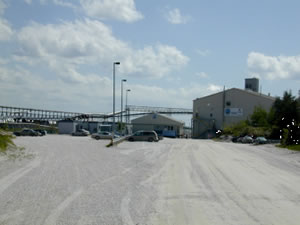
The Tanco pegmatite is a “rare-element” pegmatite of the lithium-cesium-tantalum (LCT) type. LCT pegmatites are mineralogically differentiated from other types by the following:
The Tanco pegmatite is an excellent example of the complex type–petalite subtype of LCT pegmatite.
Geologic Setting
The Tanco pegmatite, situated at the western end of Bernic Lake, is an extremely fractionated, rare-metal, complex type-petalite subgroup, LCT pegmatite and is hosted by a late stage, subvolcanic metagabbro amphibolite. The age of the Tanco pegmatite is approximately 2.576 billion years (Cerny et al, 1996).
The pegmatite is blind or buried and only sub-crops in a limited area in the bottom of Bernic Lake. Based on many diamond drill holes, the pegmatite has a maximum length of 1,990, a maximum width of 1060 metres and is up to 100 metres thick. The total tonnage of the pegmatite is calculated to be approximately 25 million tones (Stilling, 1998)
It is felt that the pegmatitic fluids that formed the Tanco pegmatite were injected into a sub-horizontal joint set with vertical joints enabling the hydraulic “lifting” of the overlying block of metagabbro.
Pegmatite Zonation

Internally, the Tanco pegmatite is composed of nice discrete zones with different mineralization of economic interest –tantalum, spodumene, pollucite and rubidium –each essentially occurring in different zones.
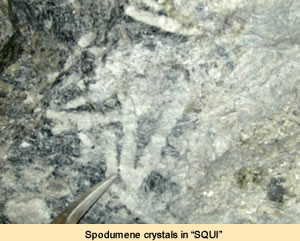
Mining
Mining is carried out using the “room and pillar” method. The excellent ground conditions and the need to utilize selective mining because of the various ores recovered, were the reasons that this mining method was utilized. The “rooms” were originally 16metres square but are now set at 22 metres after years of experience, geotechnical work and careful design.
Mining is mechanized with two-boom jumbos performing most drilling. Occasionally, a single-boom Simba longhole drill is used, particularly in pillar reduction where geometry permits. Ore is mucked and transported using 5, 6 and 7 cubic yard scoop trams and a 20 ton truck. Ores are dumped into ore passes located throughout the mine and then transported by train to the shaft on a tramming level in four-ton Granby style cars. The ores are hoisted to surface via a four ton skip. Mine ventilation is downcast from surface using two fresh air raises. The mine exhaust up casts through the access decline. Air volume required to service the mine is around 5300 cubic metres per minute.
Mineral Processing
The concentrator is constructed on a peninsula of Bernic Lake beside the other mine buildings and offices. All of the ores are crushed down to ,12mm in size. The tantalum, spodumene and pollucite ores are then stored in separate fine ore bins.
Tantalum Processing The tantalum process involves a number of steps and types of equipment. Simply put, the crushed feed is ground to pass 2mm. The <2mm particles are then moved through a series of spiral classifiers, cyclones, tables, belts and filters to produce a concentrate that contains 35-38% tantalum oxides, 14-18% Tin oxide, 5-8% Niobium Oxide and 2-4% titanium oxide.
Tanco’s tantalum concentrates are shipped to Cabot Performance Materials’ facility in Boyertown, Pennsylvania for conversion to the titanium metal or tantalum compounds.
Tantalum is a very useful metal with unique properties. The major uses of tantalum are in the electronics industry and for cutting tools. High quality capacitors are the major single use for tantalum. Tantalum carbide is used in production of hardmetal alloys for cutting tools, mainly in Europe. Other tantalum alloys are important constituents of aero engines as well as in acid resistant pipes for the chemical industry. Tantalum pins are used for medical purposes such as hip-joint replacement, since tantalum is the only metal that is not rejected by bodily fluids.
Spodumene feed at the Tanco Mine is moved through a complex series of processes including heavy media separation, grinding, magnetic separators, cyclones, tables and driers. Concentrated products ranging from 5.00% to 7.25% Lithium are produced in the process.
Most spodumene, today, is used in the manufacture of glasses and ceramics. Lithia is a powerful flux and the lithia component of spodumene can have a dramatic effect on the properties of ceramics, glazes and glasses providing benefits to manufacturers of these products. Effects such as lower viscosity, faster melting and higher gloss enable manufacturers to sped up production, have less flaws (bubbles) and increase the ability to make more elaborate, attractive products.
The other major product made at Tanco mine is cesium formate. Pollucite ore is selectively mined at Tanco along with the tantalum and lithium ores. Tanco mine contains approximately 75% of the known world proven reserves of pollucite. The ore is crushed and ground to -12mm and then dry ground in a ball mill to powder form. With a series of acid/base reactions, the cesium is extracted from the pollucite ore and converted to a high-density cesium formate solution.
Cesium formate is a water clear, water soluble fluid with a specific gravity of 2.3g/cc (two and one third times the density of water). It is used in the oil drilling industry as a drilling fluid where the properties of low viscosity, high specific gravity and complete solution have significant benefits over traditional bentonite/barite drill muds in deep wells greater than 4,575m (15,000 feet!). The cesium formate eliminates formation damage which results in improved hydrocarbon flow from the reservoir in the long term. This means that more hydrocarbons can be extracted from the formation before stimulation techniques are necessary. Cesium formate has low toxicity to people and the environment which is an important added benefit.
Specimen Mineralogy

This section will be concerned with minerals that occur in well formed crystals and/or rare minerals that can be recovered as specimens. It will primarily deal with minerals that I have a first-hand knowledge of. There are many excellent papers on the mineralogy and geology of the Tanco pegmatite if you want greater detail about mineralogy. One in particular is: Cerny, P, Ercit, T.S., Vanstone, P. Mineralogy and petrology of the Tanco rare element pegmatite deposit, southeastern Manitoba, International Mineralogical Association, 17th General Meeting Toronto 1998, Field Trip Guidebook B6. The various minerals will be treated alphabetically.
This section is, presently, rudimentary but I will try and upgrade it as I learn more about the specimen mineralogy and geology of the Tanco Pegmatite.
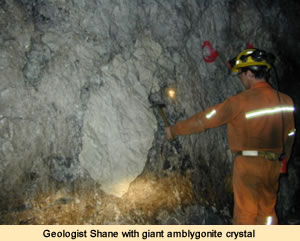
Albite Albite is ubiquitous at Tanco mine. Normally it is massive to fine grained in many ore types. The spectacular “aplitic albite” which ranges from grey-blue in colour forms wondrous rounded aggregates in contact with massive quartz. Occasionally, well formed albite crystals are found in vugs in the…….zone. The crystals are colourless and often associated with tiny apatite crystals and cookeite.
Amblygonite This mineral occurs in very large crystals at Tanco but, unfortunately, not in fine crystals. It does occur in large rounded white crystals, sometimes with a yellow colour and usually with a montebrasite alteration rim.
Analcime is found in very well formed crystals in cavities in SQUI. The crystals are lithium-rich and lustrous showing the trapezohedral form.
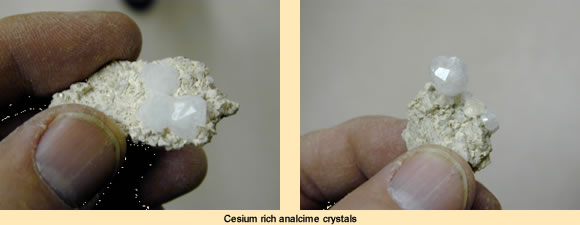
Apatite is present in all zones of the pegmatite but rarely in good crystals. In cavities, it is often found fully or partially coating quartz crystals or the vug walls as beige microcrystals or smooth botryoidal coatings on quartz. Rarely, it is found in cavities as red-purple radiating/rounded aggregates of radiating crystals to 10mm or so in size.
Apatite is often seen as blue blebs, aggregates and rounded crystals throughout the mine.
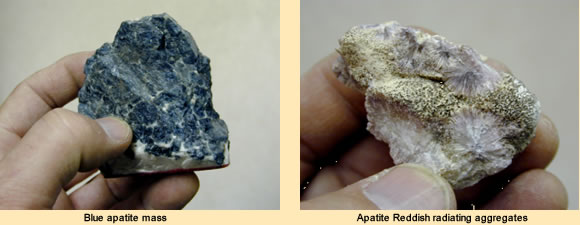
Arsenopyrite occurs, occasionally, as well formed crystals and crystal aggregates at Tanco Mine.
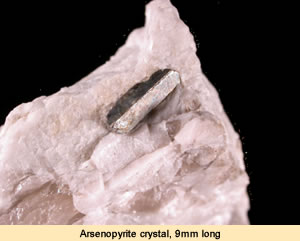

Beryl The beryl at the Tanco mine, generally is a very white colour, sometimes with a yellowish cast. Beryl crystals at the Tanco Mine are usually simple hexagonal prisms terminated by a pinacoid. They are not generally very elongated compared to beryl crystals from other deposits but, usually do not have a length to width ratio greater than 2:1. Often, the crystals are tabular-hexagonal. In terms of size, beryl crystals at Tanco have been found up to 15cm in diameter and to 30cm in length. More commonly, they are in the 6-7cm diameter range or smaller. The crystals are usually found at the interface between albite and quartz in the Main Zone and are often associated with good grade tantalum ore. Occasionally, the pinacoidal faces of the beryl crystals have a cap or zone of tiny columbite-tantalite crystals on the pinacoidal faces.
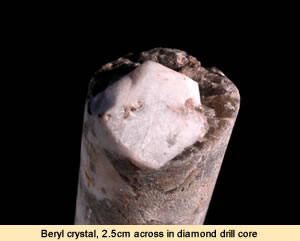
The Beryl crystals at Tanco Mine are not uncommon but recovery of specimen-grade crystals is difficult. Because the crystals are always “frozen” in quartz, the quartz must somehow be separated cleanly from the beryl to reveal the full crystal. Most often, the quartz is slightly intergrown with the beryl crystal faces, holding the crystals fast and causing them to shear when an attempt is made to remove the quartz. Occasionally, the beryl faces are smooth and less intergrown with the quartz, enabling the clean removal of the quartz to expose the beryl crystals.

Bismuthinite is not a common mineral at the Tanco mine but does occur on occasion. It occurs as coarse, bright metallic cleavages in quartz albite

Lepidolite is common at the Tanco Mine, although it does not occur in good crystallized specimens. The lepidolite is most commonly in large masses of fine-grained, interlocking crystals. These masses are very compact and actually make excellent lapidary material since they cut well and take a very nice polish. Some local artisans make very nice carvings out of this purple-coloured rock.
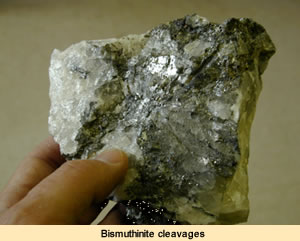
Lithiophosphate This is a rare mineral at the Tanco mine but it has been found in excellent, colourless, cleavages.
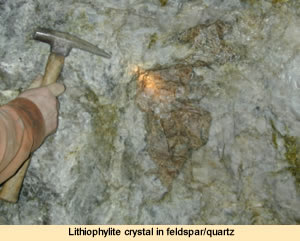
Lithiophylite is not a particularly common mineral at the Tanco mine but occasionally occurs as large rounded crystals in quartz/albite.
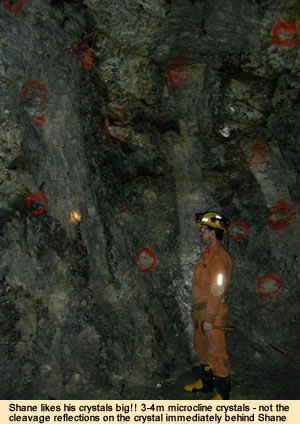
Microlite is another Tantalum-bearing oxide that occurs at the Tanco mine, and in some zones is considered an ore mineral. The only good crystals that I have seen have been colourless, micro-crystals coating titanowodginite crystals in vugs filled with calcite, where the calcite has been leached out with weak acid.
Microcline Microcline is a common feldspar at the Tanco mine but it occurs in UN-commonly sized crystals. As you can see in the image on the right, the crystals of microcline can easily attain lengths of 3-4 metres in size!

Muscovite This Mica Group mineral occurs fairly commonly at the Tanco Mine, most interestingly as rounded “curvilinear” aggregates that mine workers call “ball pien mica”. When in this habit, the muscovite resembles silvery to purple-silvery rounded crystals that do resemble the rounded end of a ball-pien hammer! This muscovite has a high Lithia component and is often referred to as lithian-muscovite.
Petalite is relatively common at Tanco Mine but not in good crystallized specimens.
Pollucite The Tanco Mine is the worlds greatest economic concentration of cesium, due to the very large zone of massive pollucite in this amazing pegmatite. The pollucite is massive, often showing a layered look with clear bands alternating with milky. Unfortunately, crystals of pollucite are not found at the Tanco Mine, except perhaps as micro crystals.
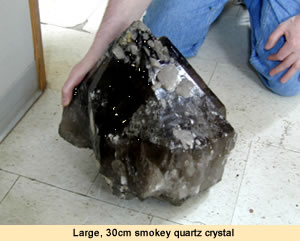
Quartz There is a LOT of quartz at the Tanco Mine particularly in the very large Quartz Zone. Generally, the quartz is massive and white but, occasionally, there are vugs which contain very well formed crystals up to 30cm or so in size. They are usually clear and colourless but can be fairly “smoky, as well. Usually the quartz crystals are associated with drusy pyrite crystals and tiny apatite crystals. Often many of the quartz crystals are actually shards of crystals that appear to have continued to grow after some tectonic event shattered them in the vug.
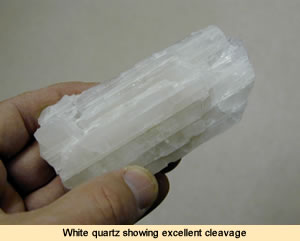
A very interesting form of quartz at the Tanco mine is the “cleavable” or, actually, “cleaved” quartz. Occurs which is cut by cleavage planes and presents an image of a mineral more like calcite or some other mineral with diagnostically good cleavage. The geologists at the mine love to show this kind of quartz to mineralogical experts and stump them when they are challenged to determine what this unusual mineral is! People are just not used to seeing cleavage in quartz. I expect that the quartz that exhibits this cleavage was thermally or mechanically shocked somehow for it to have these cleavage planes developed so well.
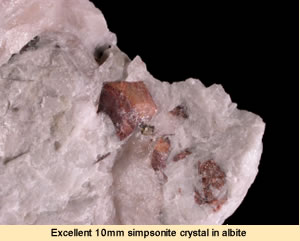
Simpsonite Here is a rare one! In places, at Tanco mine, simpsonite is an ore mineral of Tantalum. It occurs as browny-beige rounded crystals embedded in albite, occasionally as well formed crystals.
Spodumene “Spod” is a key ore mineral at Tanco Mine. While Spodumene occurs in spectacularly large crystals, embedded in quartz or albite, nice “specimen” type crystals rarely occur. Occasionally, smaller, well-formed, terminated crystals occur embedded in quartz and these can make fine specimens. Another interesting occurrence is in vuggy squi where small, gemmy, cm-sized blades of spodumene occur in cavities with analcime.
Tantalite This mineral is one of the main ore minerals of the Tantalum. It occurs in several of the zones of the mine from sparse concentrations to very rich, high-grade zonatons. Generally crystals are small but, on occasion, large prismatic crystals are mined. Some nice specimens of tantalite crystals have been recovered over the years but nice ones are rarely encountered, in recent times.
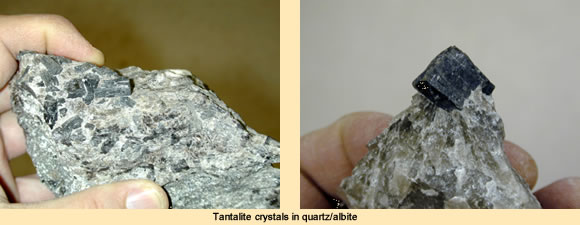
Tourmaline is common at the Tanco Mine but does not often occur in collectable crystals. The wall zone has lots of black crystals embedded in the feldspar but the crystals are tightly held and rarely can be freed from the other enclosing minerals.
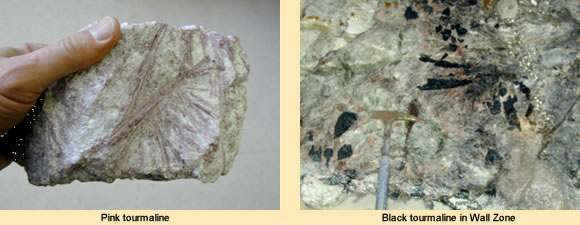
On occasion, very nice pink crystals of tourmaline are encountered embedded in fine grained lepidolite. Specimens of this material can make very attractive specimens.
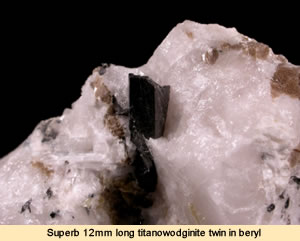
Tryphylite does not occur in well formed crystals at Tanco but does occur in large, dark yellow crystals embedded in other minerals.
Wodginite Group Several minerals of the Wodginite group have been found at the Tanco Mine. Most interesting in recent times are the excellent titanowodginite crystals found embedded in white beryl and smoky quartz in the “beryl pit” in the main zone. The Tanco mine is the type locality for titanowodginite. The crystals occur as very well formed, doubly terminated, single, wedge-shaped crystals and, more rarely, v-shaped twinned crystals. The single crystals are usually in the 3-4mm size range while the twinned crystals can range up to 20mm in length (rare), making these the largest crystals of this mineral in existence. The crystals are black, often with a curious light iridescent sheen to them.
Wodginite also occurs in radiating clusters embedded in quartz and albite. The wodginite is dark brown and shows a distinctive radiating crystal structure.
Wodginite group minerals are key ore minerals at the Tanco mine. Blobs, patches and particles of wodginite group minerals are common in certain parts of the mine but have little interest as mineral specimens.
